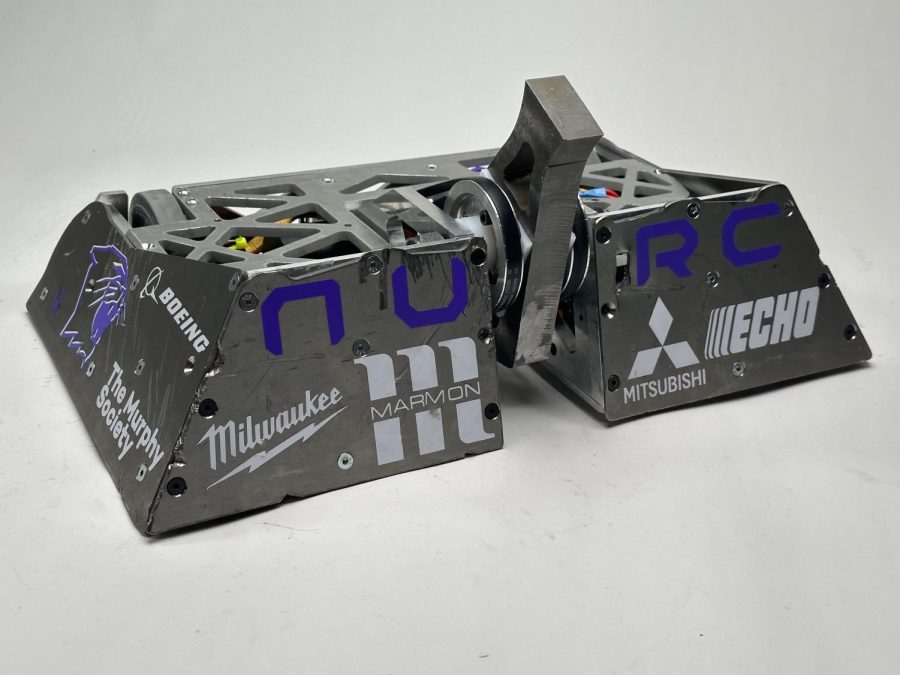Northwestern Robotics Club talks fighting robots, gears up for future competitions
Photo courtesy of Garrett Short
Northwestern’s Robotics Club competed in its first Norwalk Havoc Robot League’s world championships last December. The team is already set to compete at it again this year.
March 1, 2023
The Northwestern University Robotics Club debuted “George,” a combat robot, to fight in the 30-pound weight class competition at the Norwalk Havoc Robot League’s world championships in Connecticut last December.
Though the team entered the contest with an open mind about their prospects, Weinberg junior and NURC co-Corporate Outreach Chair Katie Mumford said the announcer at the club’s first fight made it sound like George didn’t really stand a chance. Leading up to the fight between George and “RIPperoni” — a robot from Omega Team — Mumford said the announcer raved about the opposing team’s 30-pound metal box.
When NURC won the contest, the team was ecstatic, Mumford said.
“When we won that first fight against these professional engineers, who are getting all hyped up, and just me looking at my teammates and seeing everyone’s so excited — that was just amazing,” Mumford said. “We could have gone home then and I would have been happy.”
December’s competition was the first time the club’s combat robotics team competed at NHRL’s championships, where robots enter the arena to fight against each other.
McCormick junior and NURC co-President Jackson Bremen said the club did not have a large enough team to travel to competitions that weren’t within driving distance, like the world championships, prior to this academic year.
At the world championships, teams from across the globe with different skill levels are invited to compete. Each team proceeds through a 25-seed bracket in double-elimination rounds — that is, until it loses its two matches.
Mumford said NU was one of two collegiate teams in the 30-pound weight class, the other team being a more established club. The world championships marked the first time she was able to drive the robot in a tournament.
“We’re all just like truly student-run and design and build,” Mumford said. “December was an amazing moment for all of our team members to see just how much potential we have but also how much talent we also have.”
While NURC entered the competition hoping to win at least one contest, the group walked out of the championships with an overall 13th-place ranking worldwide and two of four wins in the 30-pound category — and a competitive drive, Mumford said.
According to combat robotics lead and McCormick senior Garrett Short, many competitors at NHRL also compete on the TV show BattleBots, where robots fight in the 250-pound weight class.
“There’s a lot of experience and money being thrown around (at the competition),” Shorts said. “It’s always really cool to see other people’s robots and their innovations — and since it was a world championship, it was like the best of the best.”
It took NURC three tries to qualify for last year’s championships, Bremen said.
But, Mumford said George’s new upgrade to the now-named “DeathPact” helped the team win its first qualifying event for this year’s world championships, which will be held in November.
“We feel like there’s a little bit of unfinished business there because we’d like to do better in the future,” Bremen said. “We’re really proud of how we did. I’m really proud of everyone on the team.”
Bremen and Mumford said one of the team’s best aspects is that it’s inclusive of students who may not encounter similar mechanical work in coursework as they do in NURC.
Mumford said NURC offers a competitive outlet and learning opportunity for students to learn how to design, manufacture and build robots.
“We are, first and foremost, extremely committed to fostering a safe and fun environment for people of all identities and backgrounds,” Mumford said. “We are very serious about no-barrier entry and creating a really comfortable culture for anyone interested in STEM.”
At the upcoming November championships, Mumford said she will likely drive George again.
However, prior to competing, she said the team still has some improvements to make to DeathPact.
“Our biggest weakness, even to this day, is that if we get hit really hard or flipped over, we cannot drive upside down, and we can’t flip ourselves back over — so we just look like a turtle on its shell,” Mumford said. “Hopefully, we’ll fix that.”
Email: [email protected]
Twitter: @amittal27
Related Stories:
— University of Chicago Prof. Sarah Sebo presents robot-human interaction research
— Northwestern researchers develop smallest-ever walking robot in crab shape
— Northwestern professor Brenna Argall featured on CBS’s “Mission Unstoppable”


